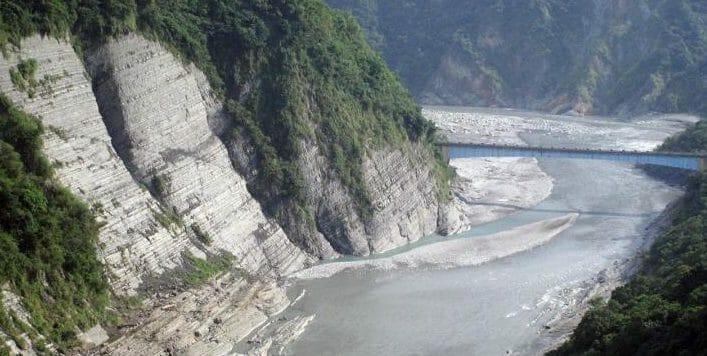Erosion May Be a Carbon Source, Study Suggests
A look at erosion in Taiwan reveals a new set of greenhouse gas sources, raising the possibility that the links between rock, rainfall and climate control may need revision. Taiwan’s erosion-prone central mountains. (Robert Hilton / Durham University)
Taiwan’s erosion-prone central mountains. (Robert Hilton / Durham University)
Researchers have challenged one of the few certainties of earth and climate history: the link between erosion and the drawdown of carbon dioxide from the atmosphere.
For decades, it has been a given that heavy rainfall on steep mountain slopes is likely to chemically weather the exposed rock and precipitate a chemical reaction that ends with carbonate minerals on the ground and with less of the greenhouse gas carbon dioxide in the atmosphere.
So geochemistry and the weather between them help moderate the planet’s climate.
But geologists and oceanographers who took another and closer look at the process in action – in the central mountains of Taiwan, hammered by three or more major typhoons each year – say they are not so sure.
They report in the journal Science that the same erosion process could be a source of carbon dioxide, releasing it into the atmosphere far faster that it can be absorbed by the newly exposed rock.
And the agency at work in this unexpected process could be biology: the researchers found evidence that tiny microbes in the mountain soils were consuming sources of organic carbon trapped in the rock, and releasing CO2 into the atmosphere.
On the face of it, the process may not be severe enough to upset the global calculations that add up to what climate scientists call the carbon budget – the annual traffic of carbon in the form of greenhouse gases from atmosphere to living things and then into the rocks and oceans – but it is yet another reminder that the climate machinery is still incompletely understood.
“This goes against a long-standing hypothesis that more mountains mean more erosion and weathering which means an added reduction of CO2. It turns out it’s much more complicated than that,” said Jordon Hemingway, of Harvard University, who led the study.
The Earth’s crust, powered by heat from the mantle below, is permanently in a state of levelling and reconstruction: powerful subterranean forces build mountains and the steady attrition of wind and rain immediately begin the process of wearing them down.
Complicated Picture
But mountains are part of the climate machine. There is a theory that the rising of the Himalayas and the Tibetan plateau provided the barrier that made the South Asian monsoons possible, and a secondary theory that the increased rainfall on the freshly raised mountain slopes weathered so much rock that the planet’s levels of atmospheric carbon dioxide took a dive, to precipitate 30 million years of Ice Ages.
A closer study of the soil, bedrock and river sediments in Taiwan revealed a more complicated picture. The scientists found that almost 70% of the organic carbon initially present in the weathered bedrock had been oxidised by soil microbes, to put, for every square kilometre they measured, somewhere between six and 18 tonnes of carbon back into the atmosphere.
This is not enough to set alarm bells ringing. But it does suggest that the intricate details of the carbon budget depend not just on what happens on the planet’s surface, but also in the teeming life beneath – and sometimes far beneath – the surface.
This is basic research at a down-to-earth level: climate science can’t make sense of what is happening now without a better understanding of what has always happened, and of the swings in planetary temperatures over the past 4.5 billion years.
Clear Understanding
Researchers are confident that they understand the cycle of Ice Ages, and they also have a clear idea that the biosphere plays a hand in keeping the planet at liveable temperatures, but they also know that the high altitudes are more than usually affected by climate change driven by ever-higher ratios of greenhouse gases released by the combustion of fossil fuels by seven billion humans.
Their fears extend to Alpine economies and the plants and animals that live in the mountains. Now it seems clear that some long-term questions require explanation at the microscopic level.
“Looking backwards, we’re most interested in how these processes managed to keep the levels of CO2 in the atmosphere more or less stable over millions of years. It allowed Earth to have the climate and conditions it’s had – one that has promoted the development of complex life forms,” Dr Hemingway said.
“Throughout our Earth’s history, CO2 has wobbled over time, but has remained in that stable zone. This is just an update of the mechanism of geological processes that allows that to happen.”
Your support matters…Independent journalism is under threat and overshadowed by heavily funded mainstream media.
You can help level the playing field. Become a member.
Your tax-deductible contribution keeps us digging beneath the headlines to give you thought-provoking, investigative reporting and analysis that unearths what's really happening- without compromise.
Give today to support our courageous, independent journalists.








You need to be a supporter to comment.
There are currently no responses to this article.
Be the first to respond.